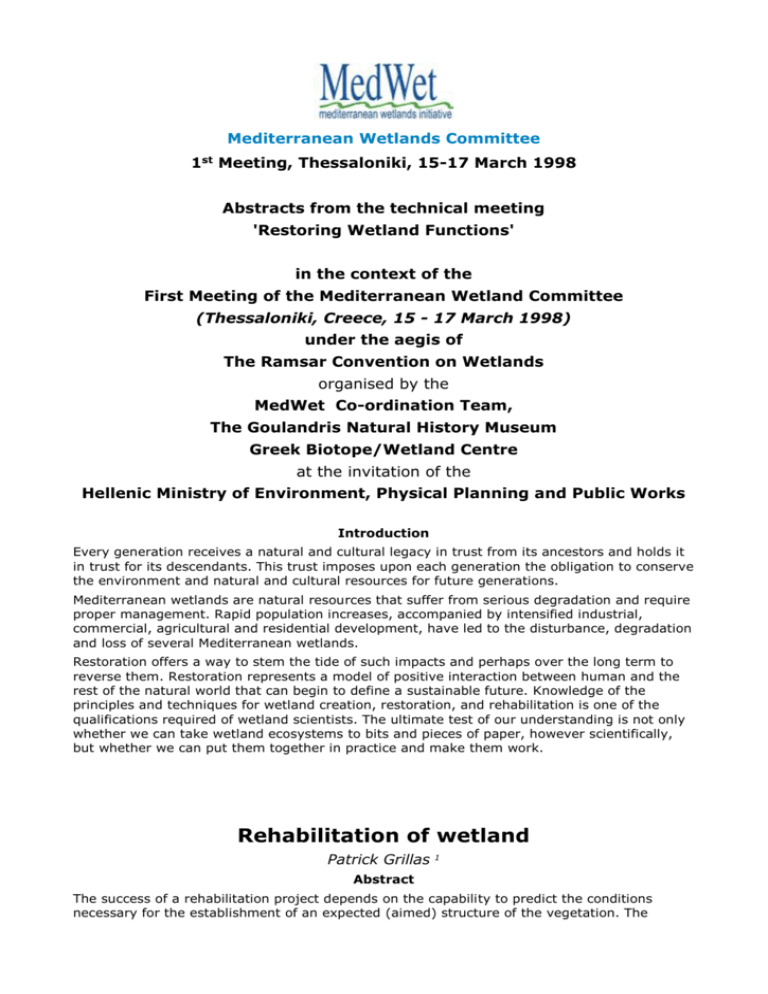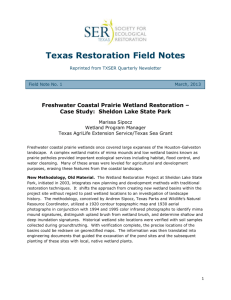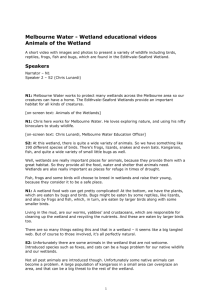MedCom1 tech-meeting - main (en)
advertisement

Mediterranean Wetlands Committee 1st Meeting, Thessaloniki, 15-17 March 1998 Abstracts from the technical meeting 'Restoring Wetland Functions' in the context of the First Meeting of the Mediterranean Wetland Committee (Thessaloniki, Creece, 15 - 17 March 1998) under the aegis of The Ramsar Convention on Wetlands organised by the MedWet Co-ordination Team, The Goulandris Natural History Museum Greek Biotope/Wetland Centre at the invitation of the Hellenic Ministry of Environment, Physical Planning and Public Works Introduction Every generation receives a natural and cultural legacy in trust from its ancestors and holds it in trust for its descendants. This trust imposes upon each generation the obligation to conserve the environment and natural and cultural resources for future generations. Mediterranean wetlands are natural resources that suffer from serious degradation and require proper management. Rapid population increases, accompanied by intensified industrial, commercial, agricultural and residential development, have led to the disturbance, degradation and loss of several Mediterranean wetlands. Restoration offers a way to stem the tide of such impacts and perhaps over the long term to reverse them. Restoration represents a model of positive interaction between human and the rest of the natural world that can begin to define a sustainable future. Knowledge of the principles and techniques for wetland creation, restoration, and rehabilitation is one of the qualifications required of wetland scientists. The ultimate test of our understanding is not only whether we can take wetland ecosystems to bits and pieces of paper, however scientifically, but whether we can put them together in practice and make them work. Rehabilitation of wetland Patrick Grillas 1 Abstract The success of a rehabilitation project depends on the capability to predict the conditions necessary for the establishment of an expected (aimed) structure of the vegetation. The Mediterranean Wetlands Committee 1st Meeting, Thessaloniki, 15-17 March 1998 structure of vegetation controls to a large extent important functions and values of wetlands and is a better identified target than its functioning. The first operational steps of a rehabilitation project usually aim at the establishment of the abiotic conditions. Introduction of species are eventually performed in a second stage. This strategy relies upon the hypothesis that abiotic conditions are of paramount importance for the establishment of target plant communities. The aim of that work was to evaluate to what extent the structure of the vegetation could be predicted (established) only from abiotic parameters in the framework of a rehabilitation project. Firstly in a literature review we analysed the relationships between four major parameters of structure: growth form, species richness, homogeneity of distribution and dominant species. Secondly, we tested hypotheses in two ongoing rehabilitation projects describing the structure of vegetation as a result of abiotic factors (water regime and salinity) imposed (experimental) or expected (rehabilitation) and availability of species. The first is an experimental rehabilitation project conducted on 18 ha of abandoned rice fields with 6 treatments combining water regime and grazing treatments (3 replicates of 1 ha). The second project aimed at the rehabilitation of 130 ha riverine wetlands. In wetland rehabilitation, the abiotic factors control to a large extent the structure of vegetation. The often harsh abiotic conditions select species among those existing in the seed bank or arriving through dispersal. The distribution of growth form is a clear and predictable answer to the intensity of abiotic stresses along depth gradients. Similarly species distribution and structure are predictable along salinity gradients. The level of predictability of vegetation in a rehabilitation project seem to be related to the intensity of abiotic stress, and thus the potential number of species susceptible to develop successfully. Competition for resources would then be of limited importance, restricted to high biomass communities. In early stages of rehabilitation the distribution pattern of species reflect only partially the abiotic conditions because the pool of species do not fit to the new conditions. In later stages species distribution fits better to abiotic factors although competition or grazing may play a significant role. 1 Station Biologique de la Tour du Valat Wetland restoration in Denmark Palle Uhd Jepsen, Ministry of Environment and Energy, The National Forest and Nature Agency, Nature and Wildlife Section, Alholtvej, DK-6840 Oksbol Abstract The wetland areas in Denmark are over the last two centuries substantially reduced due to land reclamation and drainage. Further the water-quality of remaining lakes and coastal areas has decreased due to eutrophication. The only way to mitigate previous mistakes is to restore and rehabilitate wetlands and improve the quality of water. The ecological enhancement of degraded wetlands and habitats for waterbirds is an integrated element in the Danish Government’s policy on conservation of wetlands. In the years 19891997 a total of about DKK 460 million (ECU 61 million) have been spent on nature management and wetland restoration. Mediterranean Wetlands Committee 1st Meeting, Thessaloniki, 15-17 March 1998 The paper presents the overall Danish wetland management policy, criteria for restoration and three examples on accomplished wetland restoration projects. Recent wetland restoration projects in Spain : successes and failures Francesco Giro, Senior adviser, Catalonian Government Abstract Wetland restoration in Spain is a relatively recent science and technology. In fact, most restoration projects took part after 1985. There have been a number of restoration activities going on in most of the country. Some of them are related to water quantity, with examples in Daimiel National Parks, Donana and other major wetlands. There have been a number of projects where the main problem was water quality. A couple of these cases both in El Rincon (Cordoba) and la Encanyissada (Ebro Delta), will be reviewed in this presentation. Other projects include the restoration of completely lost wetlands and we will have a look at three projects in "El Clot de l'Olla" in the Albufera de Valencia, another one in La Nava lagoon in Palencia and finally, the case of Ivars lagoon in Lleida. The first two are success stories while the last one is not. Finally, we will have a look at some actions that are taking place in different wetlands in the country. Some of them can be called proper restoration, when a rice field is transformed into a freshwater wetland, but for other cases, it is not always clear when we are talking about restoration or management. In many wetlands management activities such as water level control or vegetation control through grazing have been established or re-established. In many cases this has changed completely the type of vegetation of the area and as a consequence, the whole wildlife and mostly bird populations. In some areas, management oriented towards increasing the numbers of some species of birds has had negative effects upon other wildlife and certain types of vegetation. Other management activities include the construction of artificial nesting islands for waterbirds. There are good examples in Laguna de Fuentedepiedra in Malaga, in Villafafila lagoon in Zamora, and others. There is an increasing interest in restoring wetlands both natural and artificial. More gravel pits are being restored into wildlife habitats and there are a number of plans for other major wetlands, promoted by autonomous governments, municipalities and increasingly by nature conservation organizations and foundations. Not all restoration projects and management activities have always had a proper monitoring programme going on, but more and more managers are aware that monitoring is a key element of a restoration project. Spain has a very important area of lost endorreic wetlands in areas where the price of land is still low, and where pressures are not as they used to be. On the other hand, there is a very important land area covered by rice fields in the Ebro Delta, Albufera de Valencia and Marismas del Guadalquivir, among others, that may be forced to a change of crop or land use in the near future. There will have to be imaginative ways to turn back some of this land to wetlands, and we will have to prove from the economic and social point of view that it is profitable and necessary. I believe we are facing a new era for wetlands restoration in Spain as it is becoming increasingly acceptable and the public is beginning to ask for it. Mediterranean Wetlands Committee 1st Meeting, Thessaloniki, 15-17 March 1998 SHYLOC: System for HYdrology using Land Observation for Model Calibration I.M. Shepherd, D. Al-Khudhairy, C. Kaiser+ Institute for Systems, Informatics and Safety, Joint Research Centre, Ispra, Italy +now with WASY Institute for Water Resources Planning and Systems Research Ltd, Berlin, Germany J.R. Thompson Department of Geography, University College London, England G. Zalidis Faculty of Agriculture, Aristotle University of Thessaloniki, Greece S. Hadjiyiannakis Greek Biotope/Wetland Centre, Thermi, Greece A. Refsgaard Danish Hydraulic Institute, Horsholm, Denmark Abstract Only with deterministic hydrology models is it possible to determine the environmental impact of potential changes to protected wetlands and to understand their functions in order to manage them properly. So far the use of these models has been slow due to limitations in the models themselves, the large amount of manpower required to set them up and the limited amount of data to calibrate them. The SHYLOC project aims at resolving all these problems through improvement of the models themselves and the use of an innovative method of using satellite images to determine surface water storage in networks of surface water channels. Restoration of wetland functions : the Karla case Georgios Zalidis1, Argyrios Gerakis1, Antonios Apostolakis2, Sotiria Katsavouni2 Abstract Wetland restoration is one of the most challenging aspects of management in the Mediterranean. Re-establishing wetland functions can provide society with economic benefits, can help control the pollution and increase biodiversity. Lake Karla is one of the examples in the Mediterranean basin where favourable conditions for restoration exist. The Greek government has launched a 100 million ECU (partially from EU funds) project to restore the wetland. The project is based on a conventional technical and environmental impact assessment study, as well as on a restoration study. The objective of the latter was to select the most appropriate restoration proposal and to assess each function to be restored. An approach was followed to evaluate restoration proposals based on the degree to which they restore preexisting wetland functions. We used a Geographical Information System to create the Digital Elevation Model of the wetland ideotype Mediterranean Wetlands Committee 1st Meeting, Thessaloniki, 15-17 March 1998 and two representative proposals for the restoration of Karla. The GIS also helped describe the characteristics that determine the wetland functions. The evaluation of proposals is subject to current socio-economic and environmental constraints. In evaluating future proposals, a feedback procedure was used to find the optimum proposal. The assessment of each function of the selected proposal was based on Adamus method (Wetland Evaluation Technique) in order to identify (wherever appropriate) additional interventions needed to restore the wetland functions in a more efficient way. 1 Laboratory of Applied Soil Science, School of Agriculture, Aristotle University of Thessaloniki, Greece 2 Greek Biotope-Wetland Centre, Thermi, Greece







